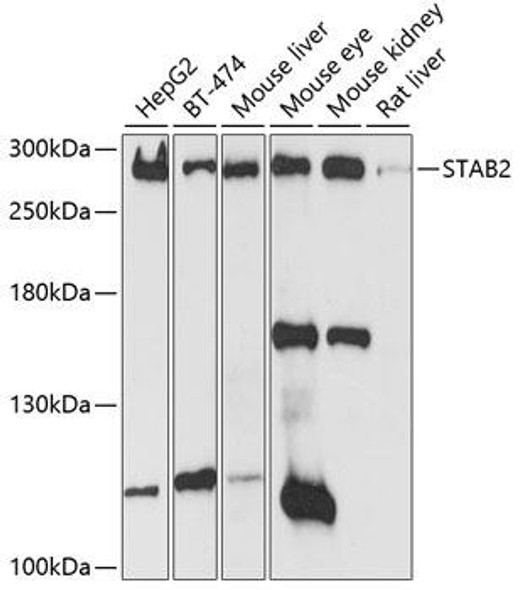Anti-LPCAT4 Antibody (CAB14316)
- SKU:
- CAB14316
- Product type:
- Antibody
- Reactivity:
- Human
- Mouse
- Host Species:
- Rabbit
- Isotype:
- IgG
- Antibody Type:
- Polyclonal Antibody
- Research Area:
- Metabolism
Description
| Antibody Name: | Anti-LPCAT4 Antibody |
| Antibody SKU: | CAB14316 |
| Antibody Size: | 20uL, 50uL, 100uL |
| Application: | WB |
| Reactivity: | Human, Mouse |
| Host Species: | Rabbit |
| Immunogen: | Recombinant fusion protein containing a sequence corresponding to amino acids 345-524 of human LPCAT4 (NP_705841.2). |
| Application: | WB |
| Recommended Dilution: | WB 1:500 - 1:2000 |
| Reactivity: | Human, Mouse |
| Positive Samples: | HT-29, HeLa, HepG2, Mouse brain, Mouse testis |
| Immunogen: | Recombinant fusion protein containing a sequence corresponding to amino acids 345-524 of human LPCAT4 (NP_705841.2). |
| Purification Method: | Affinity purification |
| Storage Buffer: | Store at -20°C. Avoid freeze / thaw cycles. Buffer: PBS with 0.02% sodium azide, 50% glycerol, pH7.3. |
| Isotype: | IgG |
| Sequence: | AGAE PGRS RMIS QEEF ARQL QLSD PQTV AGAF GYFQ QDTK GLVD FRDV ALAL AALD GGRS LEEL TRLA FELF AEEQ AEGP NRLL YKDG FSTI LHLL LGSP HPAA TALH AELC QAGS SQGL SLCQ FQNF SLHD PLYG KLFS TYLR PPHT SRGT SQTP NASS PGNP TALA NGTV QAPK QKGD |
| Gene ID: | 254531 |
| Uniprot: | Q643R3 |
| Cellular Location: | Endoplasmic reticulum membrane, Multi-pass membrane protein |
| Calculated MW: | 57kDa |
| Observed MW: | 57kDa |
| Synonyms: | LPCAT4, AGPAT7, AYTL3, LPAAT-eta, LPEAT2 |
| Background: |
| UniProt Protein Function: | AGRN: Plays a central role in the formation and the maintenance of the neuromuscular junction (NMJ), the synapse between motor neuron and skeletal muscle. Ligand of the MUSK signaling complex that directly binds LRP4 in this complex and induces the phosphorylation of MUSK, the kinase of the complex. The activation of MUSK in myotubes induces the formation of NMJ by regulating different processes including the transcription of specific genes and the clustering of AChR in the postsynaptic membrane. Defects in AGRN are a cause of myasthenia, limb-girdle, familial (LGM). A congenital myasthenic syndrome characterized by a typical 'limb girdle' pattern of muscle weakness with small, simplified neuromuscular junctions but normal acetylcholine receptor and acetylcholinesterase function. |
| UniProt Protein Details: | Protein type:Secreted; Cell adhesion; Extracellular matrix; Cell development/differentiation; Secreted, signal peptide Chromosomal Location of Human Ortholog: 1p36.33 Cellular Component: extracellular matrix; lysosomal lumen; extracellular space; cell surface; Golgi lumen; cytoplasm; integral to membrane; extracellular region; plasma membrane; synapse; basal lamina; cell junction Molecular Function:heparan sulfate proteoglycan binding; protein binding; structural constituent of cytoskeleton; acetylcholine receptor regulator activity; laminin binding; calcium ion binding; sialic acid binding Biological Process: positive regulation of filopodium formation; phototransduction, visible light; axon guidance; clustering of voltage-gated sodium channels; extracellular matrix organization and biogenesis; acetylcholine receptor signaling, muscarinic pathway; glycosaminoglycan metabolic process; neurotransmitter receptor metabolic process; pathogenesis; positive regulation of synaptic growth at neuromuscular junction; signal transduction; receptor clustering; chondroitin sulfate metabolic process; glycosaminoglycan biosynthetic process; glycosaminoglycan catabolic process; plasma membrane organization and biogenesis; positive regulation of neuron apoptosis; carbohydrate metabolic process; synapse organization and biogenesis; positive regulation of transcription from RNA polymerase II promoter; regulation of receptor activity; retinoid metabolic process; neuromuscular junction development Disease: Myasthenic Syndrome, Congenital, With Pre- And Postsynaptic Defects |
| NCBI Summary: | Members of the 1-acylglycerol-3-phosphate O-acyltransferase (EC 2.3.1.51) family, such as AGPAT7, catalyze the conversion of lysophosphatidic acid (LPA) to phosphatidic acid (PA), a precursor in the biosynthesis of all glycerolipids. Both LPA and PA are involved in signal transduction (Ye et al., 2005 [PubMed 16243729]).[supplied by OMIM, May 2008] |
| UniProt Code: | Q643R3 |
| NCBI GenInfo Identifier: | 87116681 |
| NCBI Gene ID: | 254531 |
| NCBI Accession: | NP_705841 |
| UniProt Related Accession: | Q643R3 |
| Molecular Weight: | |
| NCBI Full Name: | lysophospholipid acyltransferase LPCAT4 |
| NCBI Synonym Full Names: | lysophosphatidylcholine acyltransferase 4 |
| NCBI Official Symbol: | LPCAT4 |
| NCBI Official Synonym Symbols: | AYTL3; AGPAT7; LPEAT2; LPAAT-eta |
| NCBI Protein Information: | lysophospholipid acyltransferase LPCAT4 |
| UniProt Protein Name: | Agrin |
| Protein Family: | Agrin |
| UniProt Gene Name: | AGRN |
| UniProt Entry Name: | AGRIN_HUMAN |








